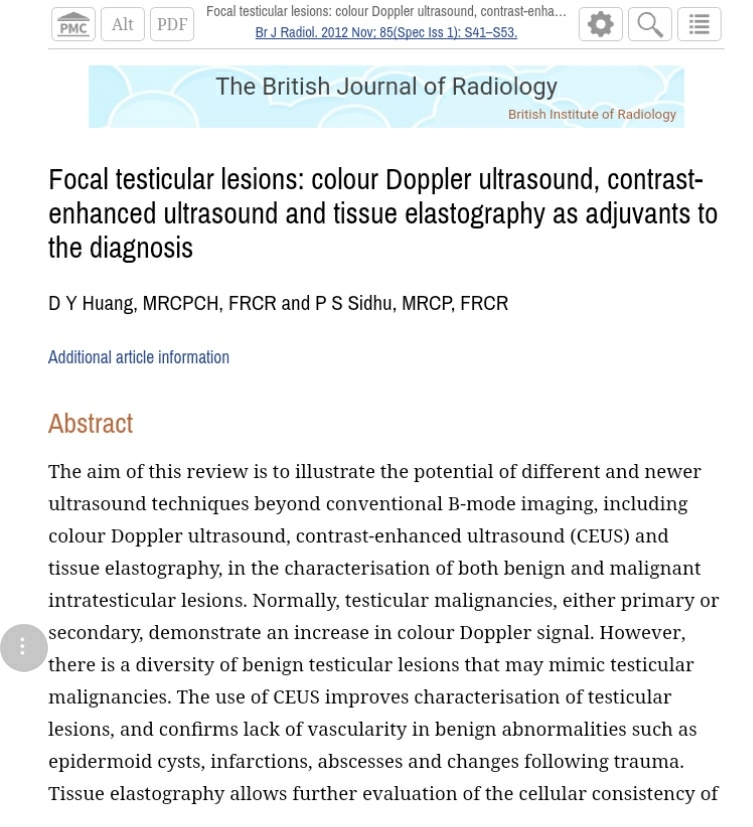
Read the complete article at: https://www.ncbi.nlm.nih.gov/pmc/articles/PMC3746409/

Read the complete article at: https://www.ncbi.nlm.nih.gov/pmc/articles/PMC3746409/
Authors: Søren Torp-Pedersen, Robin Christensen, Marcin Szkudlarek, Karen Ellegaard, Maria Antonietta D’Agostino, Annamaria Iagnocco, Esperanza Naredo, Peter Balint, Richard J. Wakefield, Arendse Torp-Pedersen, and Lene Terslev
Published in: ARTHRITIS & RHEUMATOLOGY, Vol. 67, No. 2, February 2015, pp 386–395
DOI 10.1002/art.38940
Objective. To determine how settings for power and color Doppler ultrasound sensitivity vary on different high- and intermediate-range ultrasound machines and to evaluate the impact of these changes on Doppler scoring of inflamed joints.
Methods. Six different types of ultrasound machines were used. On each machine, the factory setting for superficial musculoskeletal scanning was used unchanged for both color and power Doppler modalities. The settings were then adjusted for increased Doppler sensitivity, and these settings were designated study settings. Eleven patients with rheumatoid arthritis (RA) with wrist involvement were scanned on the 6 machines, each with 4 settings, generating 264 Doppler images for scoring and color quantification. Doppler sensitivity was measured with a quantitative assessment of Doppler activity: color fraction. Higher color fraction indicated higher sensitivity.
Results. Power Doppler was more sensitive on half of the machines, whereas color Doppler was more sensitive on the other half, using both factory settings and study settings. There was an average increase in Doppler sensitivity, despite modality, of 78% when study settings were applied. Over the 6 machines, 2 Doppler modalities, and 2 settings, the grades for each of 7 of the patients varied between 0 and 3, while the grades for each of the other 4 patients varied between 0 and 2.
Conclusion. The effect of using different machines, Doppler modalities, and settings has a considerable influence on the quantification of inflammation.
Read the Complete Article:Power and Color Doppler settings for Inflammatory Flow
Authors: Nadia Bardien1,5, Clare L. Whitehead1,3, Stephen Tong1,3, Antony Ugoni4, Susan McDonald5, Susan P. Walker1,2*
1 Department of Perinatal Medicine, Mercy Hospital for Women, Melbourne, Australia, 2 Department of Obstetrics and Gynaecology, University of Melbourne, Melbourne, Australia, 3 Translational Obstetrics Group, University of Melbourne, Melbourne, Australia, 4 School of Physiotherapy, University of Melbourne, Melbourne, Victoria, Australia, 5 La Trobe University, Mercy Hospital for Women, Melbourne, Australia
Abstract
Objectives
To determine whether fetuses that slow in growth but are then born appropriate for gestational age (AGA, birthweight >10th centile) demonstrate ultrasound and clinical evidence of placental insufficiency.
Methods
Prospective longitudinal study of 48 pregnancies reaching term and a birthweight >10th cen-tile. We estimated fetal weight by ultrasound at 28 and 36 weeks, and recorded birthweight to determine the relative change in customised weight across two time points: 28–36 weeks and 28 weeks-birth. The relative change in weight centiles were correlated with fetoplacental Doppler findings performed at 36 weeks. We also examined whether a decline in growth trajectory in fetuses born AGA was associated with operative deliveries performed for suspected intrapartum compromise.
Results
The middle cerebral artery pulsatility index (MCA-PI) showed a linear association with fetal growth trajectory. Lower MCA-PI readings (reflecting greater diversion of blood supply to the brain) were significantly associated with a decline in fetal growth, both between 28–36 weeks (p = 0.02), and 28 weeks-birth (p = 0.0002). The MCA-PI at 36 weeks was significantly higher among those with a relative weight centile fall <20%, compared to those with a moderate centile fall of 20–30% (mean MCA-PI 1.94 vs 1.61; p<0.05), or severe centile fall of >30% (mean MCA-PI 1.94 vs 1.56; p<0.01). Of 43 who labored, operative delivery for suspected intrapartum fetal compromise was required in 12 cases; 9/18 (50%) cases where growth slowed, and 3/25 (12%) where growth trajectory was maintained (p = 0.01).
Conclusions
Slowing in growth across the third trimester among fetuses subsequently born AGA was associated with ultrasound and clinical features of placental insufficiency. Such fetuses may represent an under-recognised cohort at increased risk of stillbirth.
Published in PLOS One: DOI:10.1371/journal.pone.0142788
READ THE COMPLETE ARTICLE:Placental Insufficiency in Fetuses That Slow in Growth but Are Born Appropriate for Gestational Age: A Prospective Longitudinal Study